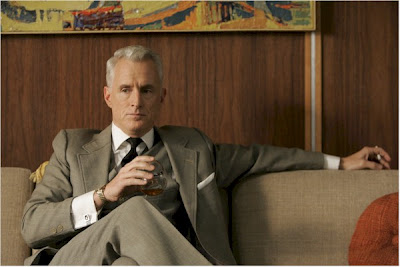
"Mad Men," having established early on in the first season that its character drink copiously, and free of care, litters latter episodes with less alcohol. Still, the references to booze and cocktails get increasingly more detailed and specific.
The character of ambitious secretary Peggy Olsen shows her sophistication in Episode 11 by ordering a Brandy Alexander—though her reaction that it's not as sweet as it should be perhaps shows she does not drink them as often as she boasts. The cocktail is appropriate. A young Brooklyn girl like Peggy would probably go for a classic "girl's drink" like the Brandy Alexander, and they did remain popular in the 1950s and 1960s. (The Beatles drank a lot of them.) Peggy's date, meanwhile, orders a nice glass of Reingold beer.
Later in the episode, Peggy is seen at home having a glass of red wine. It's Chianti, as we can tell by the pot-bellied bottle bound in straw casing. These bottles of cheap Italian vino were ubiquitous at the time. (They would become a laughable cliche, code for bad red wine, in the years to come and, then, in the 21st century, be reborn as retro hip.) It's likely that the average New Yorker would not have access to a great variety of fine wine in 1960. Chianti was an available option, and a cheap one. Peggy only makes $35 a week.
Episode 12 is entitled "Nixon vs. Kennedy," and its centerpiece is an office party in which the staff watches the election returns and generally behaves badly. These office antics are, of course, fueled by liquor. The moment the bosses are on the elevator, the workers push out a cart topped with many bottles, included a generically labeled "Vodka" bottle that the "Mad Men" art department keeps dragging out. The booze, however, quickly runs out, and the executives ask office manager Joan Holloway what stores lie in the supply closet. Actually, they ask, "What do we have too much of?" She replies, "Rum, Creme de Menthe."
Eeesh. Well, they take what they can get and it all goes into a water cooler dispensing vile green elixir.
It's no surprise that there's a lot of rum left in the supply closet. The tiki drink craze was still in full force in 1960 (though waning), so rum would be around, but the Sterling Cooper men are basically either Martini or Whiskey drinkers, with the lightweights going for beer and sometimes vodka. They don't go for Navy Grogs or Zombies.
At one point, copywriter Paul says he has a bottle of absinthe stashed in his office. It's acknowledged that it's illegal by one character. Still, it's highly unlikely that Paul would have gotten his hands of some absinthe, 45 years after it was banned in the U.S. In fact, it's doubtful that anyone in the office would have even remembered what it was, any more than they would have been going around ordering Old Tom Gin and Brandy Crustas. This could be chalked up to the fact that Paul is a would-be writer and more than a little pretentious. Or—my guess—the writers of "Mad Men" had been reading too much about the absinthe rebirth and were desperate to sneak in a reference to the old alcohol.
One last note: In Episode 10, Roger Sterling mentions an offer to take mistress Joan to The Colony. I love how dedicated "Mad Men" is to evoking the glory restaurants of New York's past (place both still living and dead). So far, characters have made visits to the Four Seasons, Rattazzi's, P.J. Clarke's and Toots Shor. So far, no one's mentioned The Stork Club, which is probably for the best; the famed nitespot was past its prime by 1960.


No comments:
Post a Comment